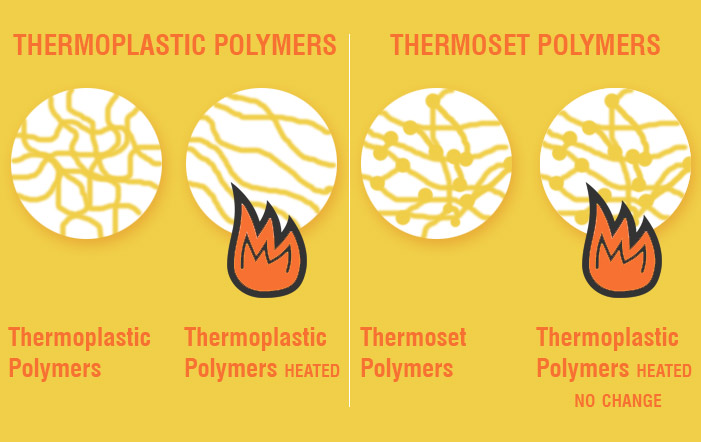Thermoplastic vs. Thermoset: What’s the difference?

A simple way to understand the difference between thermoplastic materials and thermoset materials is that while thermoplastics soften when heated, thermosets cure or harden into a mould permanently without ever remelting.
Thermoplastic
The connections in a thermoplastic become loose under the influence of heat. Beginning in pellet form, a thermoplastic material when heated becomes liquid form, allowing it to be injected into a mould. As it cools, the thermoplastic hardens into shape. This process is reversible as no chemical bonding takes place. It can be repeated through the reapplication of heat, although this deteriorates the material. Every time a thermoplastic material is melted, it loses about 20% of its original properties. A thermoplastic elastomer (TPE) can be a blended material with rubber-like properties that involves cured thermoset rubber particles to be processed within a thermoplastic portion. The generally higher compression set of thermoplastic can lead to compression set failures.
Thermoset
A thermoset material cures or sets into a hard shape using heat. Curing is an irreversible chemical reaction where cross-links are made between the material’s molecular chains to give the cured polymer a higher degree of rigidity. The chains or connections of virgin polyurethanes are stronger than the molecules and will remain stable under the influence of heat. Thermoset polymers outperform other materials such as thermoplastics in many areas, including mechanical properties, chemical resistance, thermal stability and overall durability. Thermoset materials usually make more effective seals due to their resistance to deformation.
All Oz Seals raw materials are thermosets processed in Australia. The range of billets includes:
| Oz Monyt (82 Shore D) | Oz Ultra Performance (95 Shore A) |
| Oz Super Red (95 Shore A) | Wifflon (60 Shore D) |
Explore more polymer materials made especially for the manufacture of seals on the Materials page.

